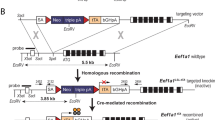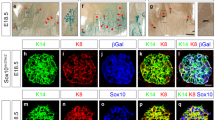Abstract
Recently, we have identified a novel 1.8 kb human Notch4/Int3 RNA species (designated h-Int3sh). The h-Int3sh RNA encodes a protein that is missing the CBF1-binding region (RAM23) of the Notch 4/Int3 intracellular domain (ICD). Expression of h-Int3sh in the MCF10A ‘normal’ human mammary epithelial cell line has been previously shown to induce changes characteristic of oncogenic transformation, including anchorage-independent growth in soft agar. To study the consequences of h-Int3sh expression in vivo on mammary gland development and tumorigenesis, three transgenic mouse lines were established, in which the transgene is the Whey acidic protein (WAP) promoter linked to h-Int3sh. Expression of WAP-Int3sh was detectable in the mammary gland at day 15 of pregnancy in each transgenic line. Mammary gland development in all founder lines is normal and the females can lactate. WAP-h-Int3sh females from each of the founder lines develop mammary tumors, but with a long latency (average age of 18 months). Tumor development was associated with activation of Notch pathway, as evidenced by upregulation of Hes-1. The long latency of mammary tumors in WAP-h-Int3sh mice could be due in part to the subcellular localization of h-Int3sh. Immunofluorescence analysis of transfected COS-1 cells showed that h-Int3sh is localized in the cytoplasm and nucleus, while Int3-ICD is detected only in the nucleus. We speculate that the Notch4/Int3 ICD-induced block to mammary gland development and tumorigenesis are consequences of an increasing gradient of CBF1-dependent Notch4/Int3 signaling.
This is a preview of subscription content, access via your institution
Access options
Subscribe to this journal
Receive 50 print issues and online access
$259.00 per year
only $5.18 per issue
Buy this article
- Purchase on Springer Link
- Instant access to full article PDF
Prices may be subject to local taxes which are calculated during checkout






Similar content being viewed by others
References
Allenspach EJ, Maillard I, Aster JC and Pear WS . (2002). Cancer Biol. Ther., 1, 466–476.
Artavanis-Tsakonas S, Rand MD and Lake RJ . (1999). Science, 284, 770–776.
Callahan R and Raafat A . (2001). J. Mamm. Gland Biol. Neoplasia, 6, 23–36.
Dumont E, Fuchs KP, Bommer G, Christoph B, Kremmer E and Kempkes B . (2000). Oncogene, 19, 556–561.
Gallahan D and Callahan R . (1997). Oncogene, 14, 1883–1890.
Gallahan D, Jhappan C, Robinson G, Hennighausen L, Sharp R, Kordon E, Callahan R, Merlino G and Smith GH . (1996). Cancer Res., 56, 1775–1785.
Gallahan D, Kozak C and Callahan R . (1987). J. Virol., 61, 218–220.
Imatani A and Callahan R . (2000). Oncogene, 19, 223–231.
Jeffries S and Capobianco AJ . (2000). Mol. Cell. Biol., 20, 3928–3941.
Jeffries S, Robbins DJ and Capobianco AJ . (2002). Mol. Cell. Biol., 22, 3927–3941.
Jhappan C, Gallahan D, Stahle C, Chu E, Smith GH, Merlino G and Callahan R . (1992). Genes Dev., 6, 345–355.
Landesman-Bollag E, Romieu-Mourez R, Song DH, Sonenshein GE, Cardiff RD and Seldin DC . (2001). Oncogene, 20, 3247–3257.
Li L, Huang GM, Banta AB, Deng Y, Smith T, Dong P, Friedman C, Chen L, Trask BJ, Spies T, Rowen L and Hood L . (1998). Genomics, 51, 45–58.
Mahler JF, Stokes W, Mann PC, Takaoka M and Maronpot RR . (1996). Toxicol. Pathol., 24, 710–716.
Martinez Arias A, Zecchini V and Brennan K . (2002). Curr. Opin. Genet. Dev., 12, 524–533.
Nieto AI, Shyamala G, Galvez JJ, Thordarson G, Wakefield LM and Cardiff RD . (2003). Comp. Med., 53, 433–438.
Pirkmaier A, Dow R, Ganiatsas S, Waring P, Warren K, Thompson A, Hendley J and Germain D . (2003). Oncogene, 22, 4425–4433.
Robbins J, Blondel BJ, Gallahan D and Callahan R . (1992). J. Virol., 66, 2594–2599.
Smith GH, Gallahan D, Diella F, Jhappan C, Merlino G and Callahan R . (1995). Cell Growth Differ., 6, 563–577.
Uyttendaele H, Soriano JV, Montesano R and Kitajewski J . (1998). Dev. Biol., 196, 204–217.
Wakefield LM, Thordarson G, Nieto AI, Shyamala G, Galvez JJ, Anver MR and Cardiff RD . (2003). Comp. Med., 53, 424–432.
White DE, Cardiff RD, Dedhar S and Muller WJ . (2001). Oncogene, 20, 7064–7072.
Acknowledgements
We thank Drs Gilbert H Smith and Barbara Vonderhaar for helpful discussions and critically reading the manuscript. This project has been funded in part with Federal funds from the National Cancer Institute, National Institutes of Health, under Contract No. N01-C0-12400.
Author information
Authors and Affiliations
Corresponding author
Additional information
Disclaimer
The content of this publication does not necessarily reflect the views or policies of the Department of Health and Human Services, nor does mention of trade names, commercial products, or organization imply endorsement by the US Government.
Rights and permissions
About this article
Cite this article
Raafat, A., Bargo, S., Anver, M. et al. Mammary development and tumorigenesis in mice expressing a truncated human Notch4/Int3 intracellular domain (h-Int3sh). Oncogene 23, 9401–9407 (2004). https://doi.org/10.1038/sj.onc.1208187
Received:
Revised:
Accepted:
Published:
Issue Date:
DOI: https://doi.org/10.1038/sj.onc.1208187
Keywords
This article is cited by
-
Inflammation and Notch signaling: a crosstalk with opposite effects on tumorigenesis
Cell Death & Disease (2016)
-
Notch signalling in cancer progression and bone metastasis
British Journal of Cancer (2011)
-
Rbpj conditional knockout reveals distinct functions of Notch4/Int3 in mammary gland development and tumorigenesis
Oncogene (2009)
-
Expression of truncated Int6/eIF3e in mammary alveolar epithelium leads to persistent hyperplasia and tumorigenesis
Breast Cancer Research (2007)
-
Kit and PDGFR-α activities are necessary for Notch4/Int3-induced tumorigenesis
Oncogene (2007)



